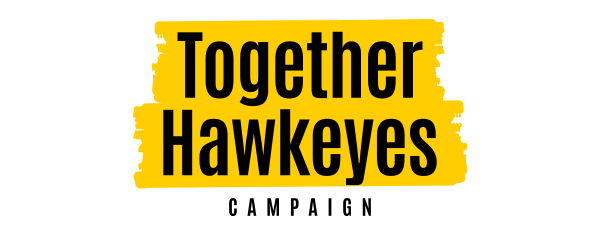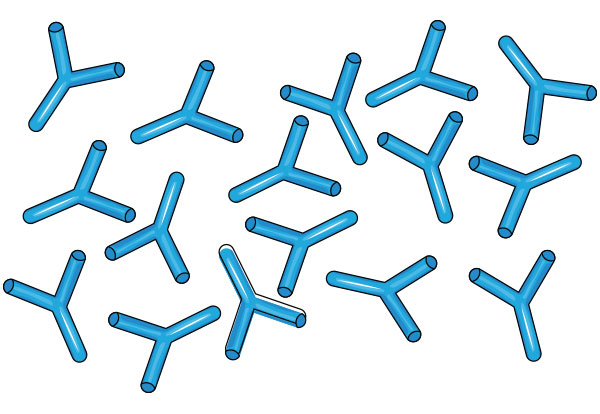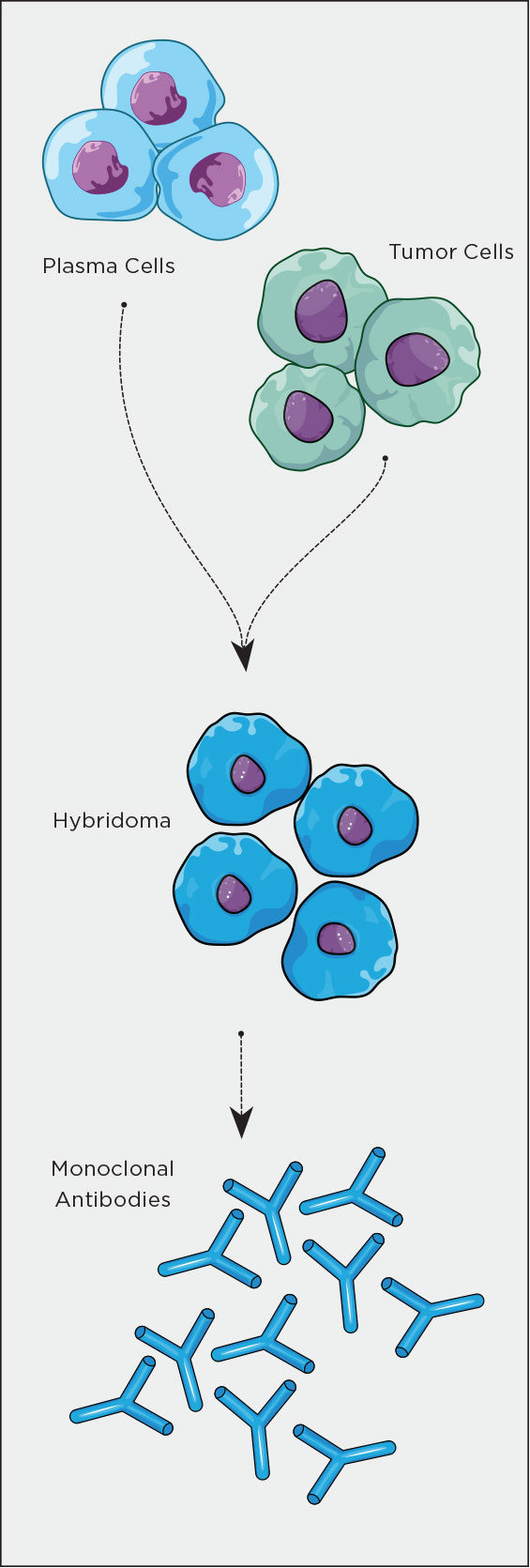Iowa Antibody Bank Stands Ready to Fight the Next Pandemic
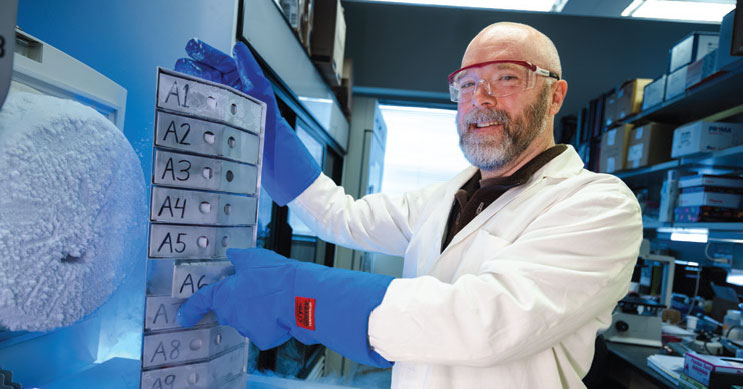 PHOTO: JOHN EMIGH
Production manager Brian Berger maintains more than 5,000 cell lines for the UI Developmental Studies Hybridoma Bank.
PHOTO: JOHN EMIGH
Production manager Brian Berger maintains more than 5,000 cell lines for the UI Developmental Studies Hybridoma Bank.
On the corner of Dubuque Street and Iowa Avenue, just a block east from the Old Capitol, thousands of possible clues toward deciphering human diseases are stored in liquid nitrogen. Floating in glass tubes, the hybridomas—cell lines used to create antibodies, the foundational pieces of human and animal immunity—hold clues to how our brains work and our muscles develop. They point the way toward treatments for cancer, Alzheimer’s, and emerging viruses that have yet to be named. They could even help combat a future pandemic.
Maintained by a small team at the University of Iowa’s Developmental Studies Hybridoma Bank, some of these hybridomas and the antibodies they create are routinely shipped to labs around the globe, while others wait to play a role in discovery. “You never know which obscure thing will suddenly be needed,” says Doug Houston, director of the bank.
Of course, many who hadn’t thought about antibodies since high school biology got a crash course during the pandemic. These proteins are central to our bodies’ immune response. In the early months of 2020, as scientists scrambled to learn how COVID-19 spread and what might deter it, the DSHB provided antibodies to multinational pharmaceutical researchers who were racing to create a vaccine.
The internationally respected depository has been located at the UI since 1996, after its formation by the National Institutes of Health a decade earlier. Scientists have used antibodies and their properties to create vaccines and treat illnesses since the late 1700s, but it’s only been since 1975 that they could be produced in a lab. Lab-produced antibodies, such as the ones created at the DSHB, are known as monoclonal antibodies.
Strictly speaking, what DSHB holds are cell lines that are used to produce monoclonal antibodies when requested by a researcher. With proper care, these cell lines and the monoclonal antibodies they produce are “immortal”—think of a sourdough starter that is refrigerated and occasionally fed, used, and restored.
OPEN SCIENCE MODEL
The repository is built on a dedication to open science—the belief that scientific research should be accessible to everyone. It works like a library. Researchers can both deposit and purchase cell lines with DSHB.
“We have a very egalitarian mission,” says Houston, who took the helm two years ago, following 25 years of leadership by David Soll. “We want to save researchers’ money on known, quality antibodies.”
Since 1998, DSHB has been self-sustaining. Many of its expenses go toward managing its collection. The bank operates at cost, making it more affordable than commercial antibody companies. For comparison, DSHB charges $45 for a milliliter, while commercial distributors ask between $400 to more than $1,000—often for a smaller amount.
So why does DSHB feel like a best-kept secret? Today, researchers can choose from many for-profit companies who sell thousands of antibodies with countless uses. DSHB, which operates more like a small, well-curated bookstore, doesn’t have the resources to host booths at conferences or advertise in journals. Researchers often learn about DSHB from their peers or mentors. Those who know about it, however, find it an invaluable resource.
THE EFFECTS OF DSHB IN THE FIELD
Tina Tootle, a professor of anatomy and cell biology at the UI’s Roy J. and Lucille A. Carver College of Medicine, runs a lab focused on prostaglandins—lipids that control processes like inflammation and blood flow and which are produced at sites of tissue damage or infection. Her elevator pitch for her work is alluring: We don’t know why aspirin works, and that’s a problem. It’s a problem in part because aspirin causes many off-target effects, like bleeding ulcers and impaired fertility.
Central to Tootle’s research are Drosophila, or fruit flies. She is part of a group of researchers informally called “the fly community,” who create and share antibodies specific to their work. DSHB serves as an invaluable middleman; it is the place where they can deposit and obtain antibodies. Drosophila is a major part of the DSHB collection, and the repository is especially known and respected in the fly community.
“We have a very egalitarian mission. We want to save researchers’ money on known, quality antibodies.” —Doug Houston
No matter how cooperative researchers are with each other, there simply isn’t time for them to make antibodies for another lab—a process that takes around a month—and ship them off.
Nor could Tootle afford the large quantities of antibodies her lab needs if she was paying commercial prices. As a graduate student, she worked in a lab that routinely purchased Drosophila antibodies from DSHB—a fact she took for granted, unaware of the pricing differences between the UI bank and commercial distributors. “Once you’re the one managing a budget you really appreciate them,” she says.
Another satisfied customer is Mark Peifer, a distinguished professor of biology at the University of North Carolina who’s also part of the fly community. His research is in the area of developmental biology, with a focus on epithelial tissues that form the basic architecture of our bodies. Why, his research asks, are you a person and not a puddle? The reason is because our cells have machinery that build the tissue that comprises your organs. He uses fluorescent tags and ever-improving microscopy to study the cell machinery, including instances of when something goes wrong with it, such as with spina bifida.
Peifer emphasizes that the savings his lab makes by purchasing antibodies through DSHB is essentially a savings for taxpayers since he is at a public university. “Their prices are phenomenally low, and they provide incredible information. Our work wouldn’t be possible without DSHB,” he says, adding that thousands of scientists would agree.
GROWING DSHB’S REACH
Karla Daniels (87PhD), a research scientist and chief curator of the DSHB, hopes the bank can secure funding to double or even triple its current production. She’d also like to see DSHB have the resources to validate and provide documentation for its entire collection, not only its bestsellers.
Cell lines often arrive at DSHB without much accompanying information. The repository inherits collections from retiring scientists as a way for a life’s work to be safeguarded into the future. Other times DSHB receives larger deposits, such as 300 antibodies recently deposited by NIH’s Brain Initiative.
“Antibodies come to us and have been vetted for one or two uses,” says Daniels, “but we want to know what else they can be used for.” As an example, she cites an antibody deposited with DSHB more than two decades ago as a target against leech neurons. Recently, researchers have realized it is a target for cancer metastasis.
Daniels and the DSHB team consider stewardship one of their most important roles. Daniels says while some monoclonal antibodies have been working for 10 years, others are very fragile. She says one of their most popular antibodies, used for fiber testing in skeletal muscle studies, must be frozen as soon as it is made.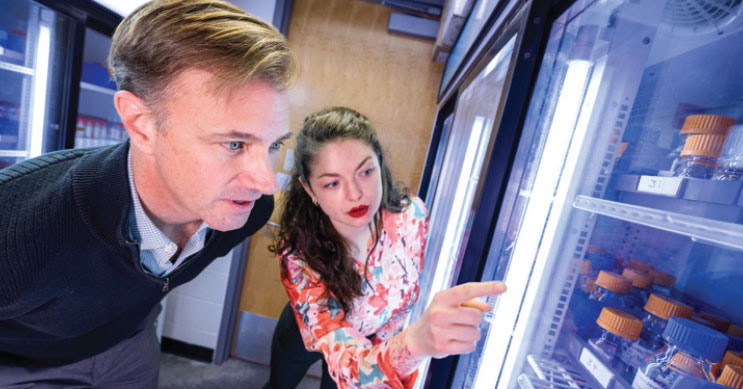 PHOTO: JOHN EMIGH
Director Doug Houston and program coordinator Gemma Kerr monitor the inventory at the UI Developmental Studies Hybridoma Bank.
PHOTO: JOHN EMIGH
Director Doug Houston and program coordinator Gemma Kerr monitor the inventory at the UI Developmental Studies Hybridoma Bank.
Ensuring the longevity of the collection is the work of production manager Brian Berger (97BS), who tracks shelf lives in numerous spreadsheets, maintaining careful schedules for checking on the health and viability of the more than 5,000 cell lines in the DSHB collection.
While commercial producers don’t have incentive to maintain rare antibodies because of the lack of profit in maintaining them, DSHB considers this central to its mission. Daniels has specifically solicited antibodies she believes should be in the bank. She also responds to researchers in need of rarer antibodies by trying to procure them for the collection.
For example, an ALS nonprofit leader cold-called Daniels saying the organization was interested in funding production of ALS-related antibodies; would DSHB be interested in partnering?
Daniels’ reaction: “DSHB is made for that!” They started with two hybridomas—which are now in DSHB’s top 20 sellers—and multiple publications have deemed them the best in the world.
Today, monoclonal antibodies are used in the diagnosis and treatment of many diseases, including some types of cancer, inflammatory and autoimmune disorders, osteoporosis, and migraines. They have enabled patients to receive organ transplants and advanced the possibilities for immunotherapy, using the body’s own immune intelligence to fend off viruses.
The body generates a unique immune response with specific antibodies depending on the disease it is fighting. With its vast library of monoclonal antibodies against known and unknown disease-related molecules, the DSHB can serve as a vital resource for researchers trying to find ways to study these unique disease processes when new outbreaks arise.
We know there will be other COVID-like events in the future. And we don’t know what will be needed to stop them. What the DSHB team is certain of, however, is that its bank of nuanced biological information holds thousands of answers to questions yet to be asked.

